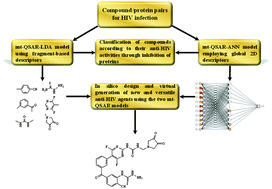A ligand-based approach for the in silico discovery of multi-target inhibitors for proteins associated with HIV infection†
Abstract
Acquired immunodeficiency syndrome (AIDS) is a dangerous disease, which damages the immune system cells to the point that the immune system can no longer fight against other infections that it would usually be able to prevent. The causal agent is the human immunodeficiency virus (HIV), and for this reason, the search for more effective chemotherapies against HIV is a challenge for the scientific community. Chemoinformatics and Quantitative Structure–Activity Relationship (QSAR) studies have played an essential role in the design of potent


 Please wait while we load your content...
Please wait while we load your content...